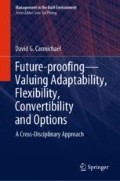Abstract
The Clean Development Mechanism (CDM) is one of three flexible emission reduction mechanisms flowing from the 1997 Kyoto Protocol [11], where certified emission reduction credits or units (commonly referred to as CERs or carbon credits) are generated in developing countries for use by industrialised countries (referred to as Annex 1 parties— [11]) in achieving their emission reduction targets. Although the Protocol expired on 31 December 2012, the eighteenth session of the Conference of the Parties (COP 18) in Qatar (UNFCCC, What is the CDM. http://cdm.unfccc.int/about/index.html, [12]) extended the duration of commitments to 31 December 2020.
Access this chapter
Tax calculation will be finalised at checkout
Purchases are for personal use only
References
Baker and McKenzie (2015) CDM Rulebook. http://www.cdmrulebook.org. Accessed 31 Jan 2015
Balatbat MCA, Findlay E, Carmichael DG (2012) Performance risk associated with renewable energy CDM projects. J Manag Eng 28(1):51–58
Carmichael DG (2014) Infrastructure investment: an engineering perspective. CRC Press, Taylor and Francis, London
Carmichael DG, Ballouz JJ, Balatbat MCA (2015) Improving the attractiveness of CDM Projects through allowing and incorporating options. Energy Policy 86:784–791
Carmichael DG, Lea KA, Balatbat MCA (2016) The financial additionality and viability of CDM projects allowing for uncertainty. Environ Dev Sustain 18(1):129–141
Department of the Environment (2015) About the carbon farming initiative, Department of the Environment. http://www.environment.gov.au/climate-change/emissions-reduction-fund/cfi/about. Accessed 31 Jan 2015
Schneider L (2007) Is the CDM fulfilling its environmental and sustainable development objectives? An evaluation of the CDM and options for improvement. Öko-Institut, Berlin, Germany
UNEP (United Nations Environment Program) (2003) CDM information and guidebook, ed M-K Lee, UNEP Riso Centre, Roskilde, Denmark
UNEP (United Nations Environment Program) (2007) Guide to financing CDM projects, CD4CDM project. UNEP Riso Centre, Roskilde, Denmark
UNEP (United Nations Environment Program) (2011) CDM information and guidebook, 3rd edn. UNEP Riso Centre, Roskilde, Denmark
UNFCCC (United Nations Framework Convention on Climate Change) (2015a) What is the CDM. http://cdm.unfccc.int/about/index.html. Accessed 31 Jan 2015
UNFCCC (United Nations Framework Convention on Climate Change) (2015b) CDM insights. http://cdm.unfccc.int/Statistics/Public/CDMinsights/index.html. Accessed 31 Jan 2015
Author information
Authors and Affiliations
Corresponding author
Rights and permissions
Copyright information
© 2020 Springer Nature Singapore Pte Ltd.
About this chapter
Cite this chapter
Carmichael, D.G. (2020). Project Delivery—CDM Projects. In: Future-proofing—Valuing Adaptability, Flexibility, Convertibility and Options. Management in the Built Environment. Springer, Singapore. https://doi.org/10.1007/978-981-15-0723-6_8
Download citation
DOI: https://doi.org/10.1007/978-981-15-0723-6_8
Published:
Publisher Name: Springer, Singapore
Print ISBN: 978-981-15-0722-9
Online ISBN: 978-981-15-0723-6
eBook Packages: EngineeringEngineering (R0)

